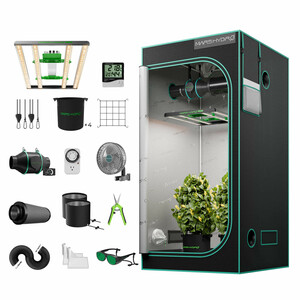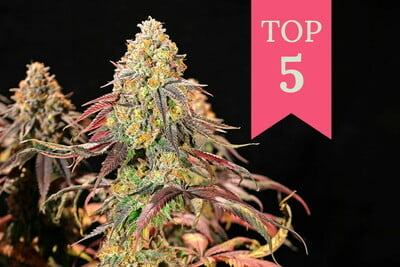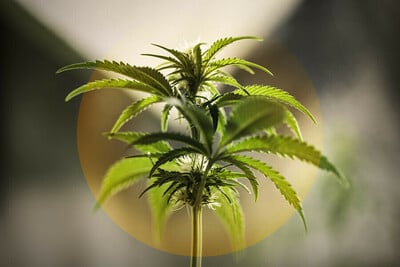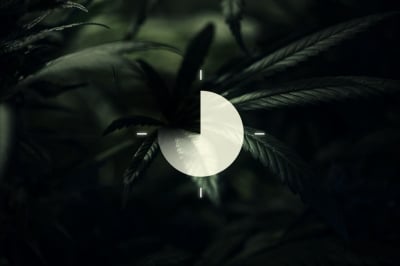 Weed Grow Guide by Royal Queen Seeds
Weed Grow Guide by Royal Queen Seeds
- Growing weed step by step
- Marijuana growing basics
- Choosing your seeds
- How to germinate seeds
- The marijuana vegetative stage
- The marijuana flowering stage
- Harvesting marijuana
- Trimming, drying, and curing
- Choosing pots and soil
-
Growing indoors
- A Complete Overview Of Growing Cannabis Indoors
- Cannabis Cultivation Tips: How To Set Up Indoor Grow Lights
- How Many Cannabis Plants Can You Grow Per Square Metre?
- Indoor Cannabis Growing: Relative Humidity and Temperatures
- Hydroponics Cannabis Growing Guide (with diagrams)
- Cannabis Micro Growing: Growing Great Weed in Tiny Spaces
- Growing outdoors
- How to grow autoflowering marijuana
- Marijuana nutrients and pH
- Marijuana troubleshooting: Nutrients
-
Marijuana troubleshooting: Growing
- Cannabis Seed Germination — Troubleshooting Guide
- How to Deal With Pythium (Root Rot) in Cannabis Plants
- Slow Cannabis Plant Growth And What You Can Do About It
- How to Prevent and Fix Stretching in Cannabis Seedlings
- Watering Your Cannabis: How to Fix Overwatering and Underwatering
- Understanding Male, Female, And Hermaphrodite Cannabis
- Identifying and Treating Common Cannabis Ailments
- How To Revive a Sick Cannabis Plant
- How to Avoid Moldy Marijuana During Drying and Curing
- How to Prevent and Treat Dry and Crispy Cannabis Leaves
- What Cannabis Leaves Can Tell You
- Causes and Solutions for Yellow Cannabis Leaves
-
Marijuana Strains Grow Report
- HulkBerry Automatic Grow Report
- Blue Cheese Auto Grow Report
- Purple Punch Automatic Grow Report
- Triple G Automatic Grow Report
- Do-Si-Dos Automatic Grow Report
- Green Gelato Automatic Grow Report
- Haze Berry Automatic Grow Report
- Purple Queen Automatic Grow Report
- Cookies Gelato Automatic Grow Report
- Sherbet Queen Automatic Grow Report
- Sweet Skunk Automatic Grow Report
- Medusa F1 Grow Report
- Marijuana plant training
-
Marijuana growing tips
- The Cannabis Plant Anatomy
- How to preserve seeds
- How Much Sunlight Do Outdoor Cannabis Plants Need To Grow?
- How to Control and Prevent Stretching in Cannabis Plants
- My Cannabis Plants Are Growing Too Tall: What Should I Do?
- Should You Worry About Purple Or Red Cannabis Stems?
- What To Do When Your Indoor Cannabis Won’t Flower
- How To Protect Your Cannabis Plants From Heat Stress
- How To Tell If Your Female Cannabis Plant Has Been Pollinated
- Growing Medical Marijuana
- Bud Washing: How to Clean Your Weed
- Understanding Cannabis Yield per Plant

Cannabis Cultivation Tips: How To Set Up Indoor Grow Lights
Learn to assess and position your cannabis grow lights for maximum effectiveness.
Contents:
- The 3 most common types of modern grow lights
- Light spectrum, par, and lumens
- Par and ppfd in watt computation
- Sun, bulbs, and proper photonic pressure
- How much light does your grow room need?
- The watts per square metre rule: how many plants can you grow?
- Hid (mh, hps): rules for the right distance
- Led: rules for the right distance
THE 3 MOST COMMON TYPES OF MODERN GROW LIGHTS
Contemporary indoor cannabis cultivation usually involves at least one of three artificial light sources: HID, CFL, and LED. Frequently, growers use a combination of grow lamps. Of course, there are other, more antiquated lighting technologies, but they are all pretty much “Betamax” lamps. This blog will focus on the most common lighting used by the 21st-century cannabis cultivator. We are going heavy on the practical grow room advice without relying on the pseudo-scientific stats.
HID or high-intensity discharge lamps have been the grow lights of choice for every kind of indoor grower from beginners to pro cultivators since the early 1990’s at least. Over the years, lamps have become more efficient, ballasts have gone digital, and reflectors have gotten bigger and better. Growers that favor HID are big believers that lumens are the only output statistic that matters when it comes to lights.
Sure, CMH or ceramic metal-halide has come on the scene and the 315W CMH bulb is impressive, but a rather expensive upgrade for a standard MH or metal-halide lamp. Moreover, 315W CMH is not quite as high performance as a high-end dual spectrum/agro 600W HPS or high pressure sodium lamp. Similarly, CFL shows some promise, but always runs a distant second to the tried and trusted HID.
LED or light-emitting diode is the up-and-coming breakaway technology that looks to end the reign of HID for cannabis cultivation. The latest generation of LED systems are now capable of producing comparable, and in some cases, superior quality marijuana than the average HID set-up. PAR or photosynthetically active radiation is the metric that LED zealots consider most important.
It’s best not to get too obsessed about the various new measures of light and modified light spectrums. Keep it simple. Think of light in terms of watts and electricity bills. Next is the question, “How much power consumption?” Followed by, “How much heat will the lamp produce and how much light will it emit?”
OLD SCHOOL HID
In ordinary decent stoner terms, HID has gotten some new bells and whistles, but the core principles of cultivating cannabis with this kind of artificial light remain the same. MH for vegetative growth and HPS for flowering. Although, the dual spectrum HPS lamps are a popular alternative and probably even better for autoflowering strains.
400W and 600W bulbs are the most suitable for indoor cannabis cultivation. Lights need to be hung level. The optimal light height or OLH is between 1 - 1.6 feet above the plant canopy. This means carefully fastening the reflector to the ceiling or roof of the grow tent with either easy roll hangers or rope ratchets.
When setting up your indoor grow, selecting the right tent size can help optimize light distribution and airflow. While even a compact tent can support a successful grow, those with more space may find that a mid-sized grow tent provides greater flexibility in plant training and airflow management.
It’s best to use fixtures that can be easily adjusted and repositioned as the plants mature and grow taller.
However, seedlings and cuttings may find a 600W MH too intense and a 23.4 inches+ distance overhead might be more appropriate.
Don’t mess with light rails unless you’ve got the engineering credentials. Stationary lights that don’t wobble with a level, horizontal bulb housed in a clean, open reflector is professional, standard cultivation. Ideally, use a large reflector, or as big as will squeeze into the grow space, with a wide spread to utilise the entire area.
Glass filters, light, and air-cooling lamps are expensive. Therefore, cool tubes are really only suitable for closet grows as they have some of the worst reflective properties of any reflector on the market. Adding more lights and more fans means higher power bills.
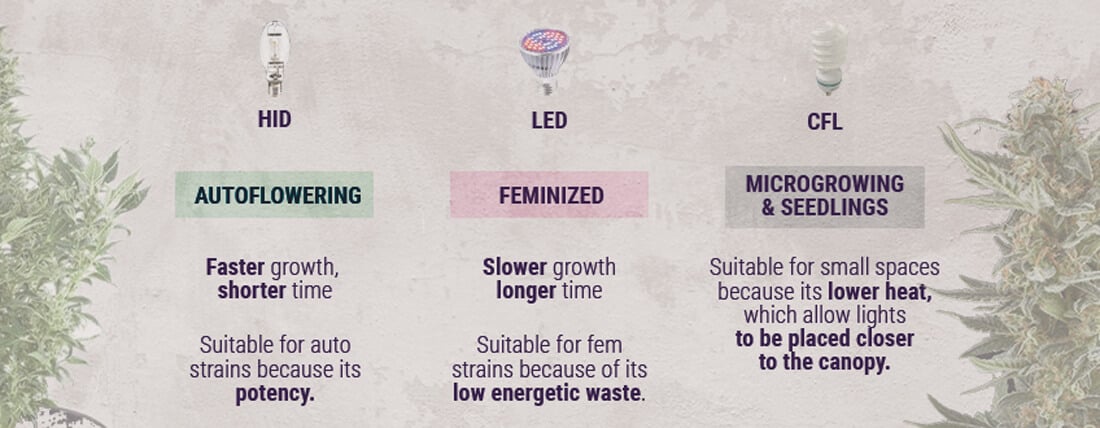
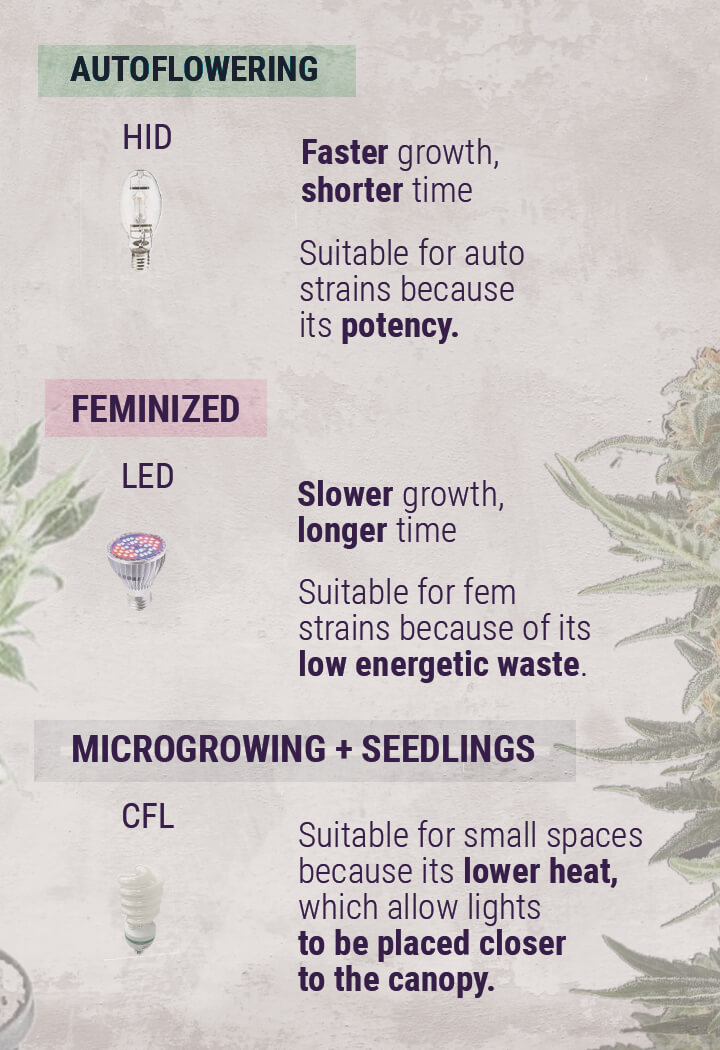
LIGHTING AND GROW SPACE
Generally, 400-600W per m² is plenty of light for a home grow show. Commercial growers may push this to 1000W+ for maximum yield. Packing as many lamps as possible into the grow-op is not a fast track to a heavy harvest. More HID lamps means more light, but also a lot more heat. These babies run hot. 250W lamps are for micro-growers only.
The only advantage the 250W lamp offers is that plant tops can get as close as 7.8 inches to the bulb. Heat output is far less than a 600W, but light will not penetrate as far. Limited light will reach the lower branches of taller plants.
The addition of just one extra 600W HPS can massively increase grow-op temps. It’s often a less costly and more effective solution to invest in upgrading the grow room instead. Maybe cover the walls in Mylar or upgrade from a magnetic ballast to a dimmable, digital ballast, or go all the way to LED.
HOW MANY PLANTS?
The answer is as many or as few as the grower prefers. You can pack 16 cannabis plants in 11l square containers into a 1m² grow space in a SOG. Alternatively, a grower can fill the same space with one large plant using the ScrOG method. Either way, the yield will be comparable. Again, it's all about how you make use of the light and the grow area.
SUPPLEMENTING WITH CFL
CFL or compact fluorescent light is really effective in the cool white spectrum as an alternative to an MH bulb. A 250W CFL can deliver comparable results to a 400W MH lamp. This is achieved by hanging the CFL as close as 3.9 inches above the plant canopy. CFL runs cool and can get really close to plants without burning foliage. Plus, CFL lights will only marginally increase grow-op temps. This makes CFL perfect for seedlings, cuttings, and for use during vegetative growth. CFL lights are sometimes the only option for micro-growers.
Unfortunately, CFL boasts neither impressive lumen nor PAR output figures. Worse, CFL lights are not very effective for flowering marijuana. Cannabis plants need far more intense illumination during bloom than CFL can supply. Expect lightweight yields and loose buds from CFL lights in the flowering phase.
NEXT-GEN LED
The latest LED systems have finally achieved parity with traditional HID lighting systems. At present, the situation is similar to when flat screen televisions first became available at the turn of the century. The benefits and advantages were plain for all to see. However, the limiting factor was prohibitively high prices by the leading manufacturers.
High-performance LED kits that draw 350-400W and can outperform a 600W MH and HPS configuration with a full spectrum array don’t come cheap. There are some models that really can do it all. The very best systems can run cool and are incredibly economic in the long-term. Hanging distances vary widely, so buyer beware and make sure to check the manufacturer’s instructions.
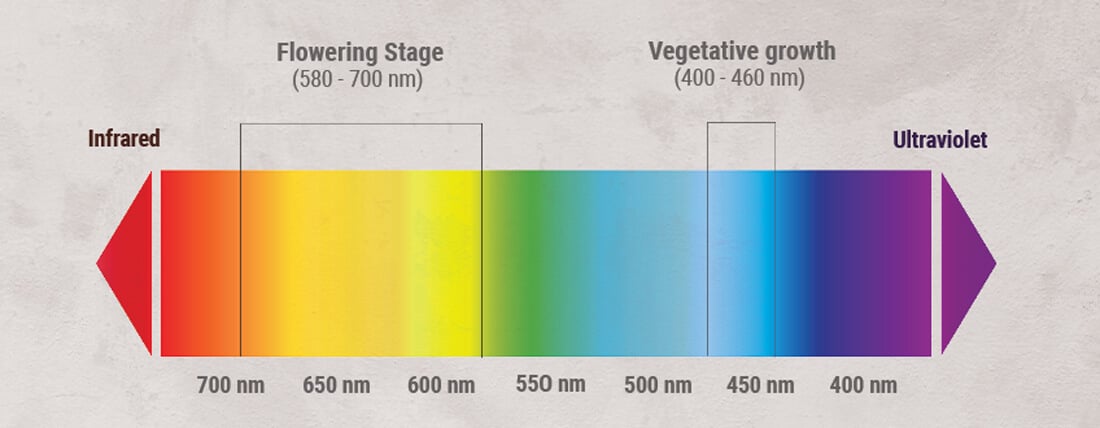
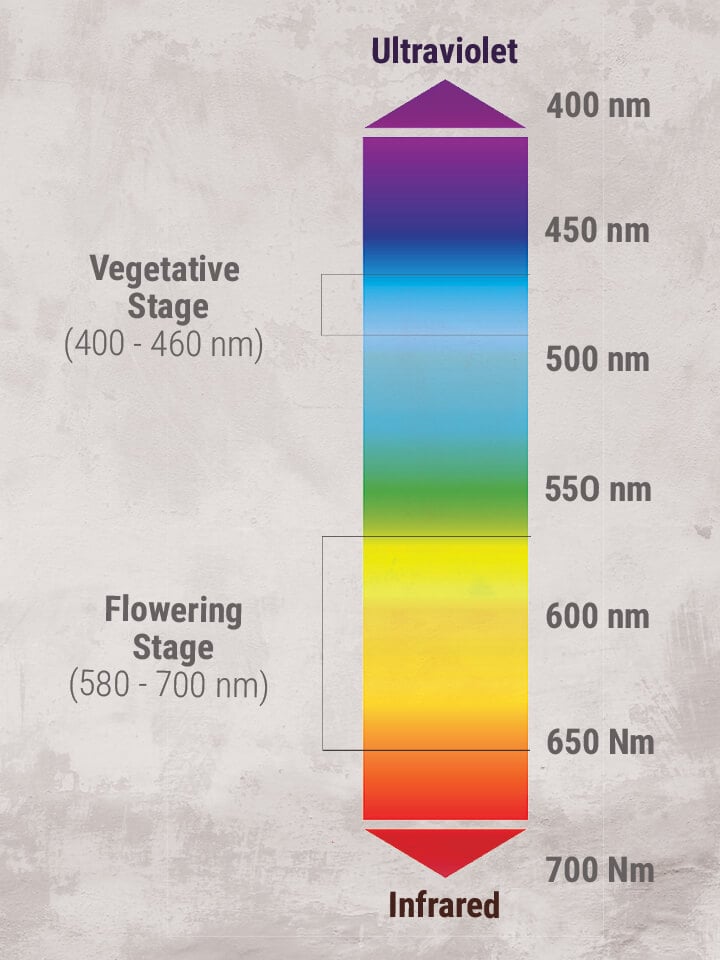
Below, we dig into the science behind light output so you can assess the ideal wattage and placement of your cannabis grow lights. We'll cover terms like photons, lumens, and PAR, as well as the main types of grow lights and how they differ.
LIGHT SPECTRUM, PAR, AND LUMENS
Light is made of photons, which are tiny particles that inevitably travel at the speed of light. Photons in light beams vibrate with different frequencies and wavelengths. Humans can see photonic radiations within wavelengths from 380–680nm, while plants’ sensitivity to light ranges from 200–800nm. Not all wavelengths within this spectrum produce the same effects on photosynthesis; those that most activate biochemical processes in plants are called PAR (photosynthetically active radiation), which has a spectral range of 400–700nm.
Light can be measured in photometric quantities derived from the human eye’s sensitivity to color, or else with radiometric quantities related to the energy transported by light beams. Lumens and lux are commonly used photometric units that refer to light perceived by the human eye.
However, photometric measurements do not indicate how much light energy a lamp sends to a plant for photosynthesis because they don’t include the PAR variables. Despite that, lumens and lux can provide an initial indication on a specific bulb’s output, and we can compare different products by measuring their photometric efficiency with the lumen:watt ratio, regardless of the eventual differences in light spectrum output at different wavelengths.
Lux and lumens work well in measuring MH, HPS, CFL and T5 lights, but they won’t accurately measure the efficiency of an LED light when growing cannabis.
PAR AND PPFD IN WATT COMPUTATION
Broadly speaking, the minimum amount of wide-spectrum light needed by a cannabis plant is around 9,000lm per square metre, while the optimal is over 20,000lm/m². However, a vigorous indoor plant’s growth and flowering depends on the light thresholds reached at specific wavelengths that trigger photosynthesis. That’s why LED grow lights use radiometric systems in order to measure the quantity of photons irradiated in the PAR color frequencies we mentioned before.
The most widely used radiometric measurement in horticulture is the PPFD (photosynthetic photon flux density), which measures the flow of PAR photonic micromoles per second in a square metre (μmol/m²/s). Assuming the PPFD of a grow light is provided, we can calculate its radiometric efficiency and compare different lighting systems using the PPFD:watt ratio.
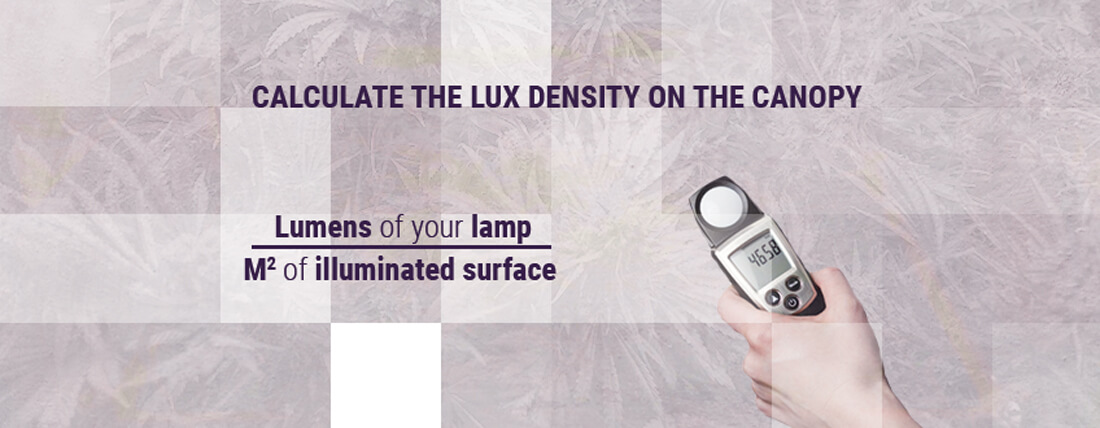
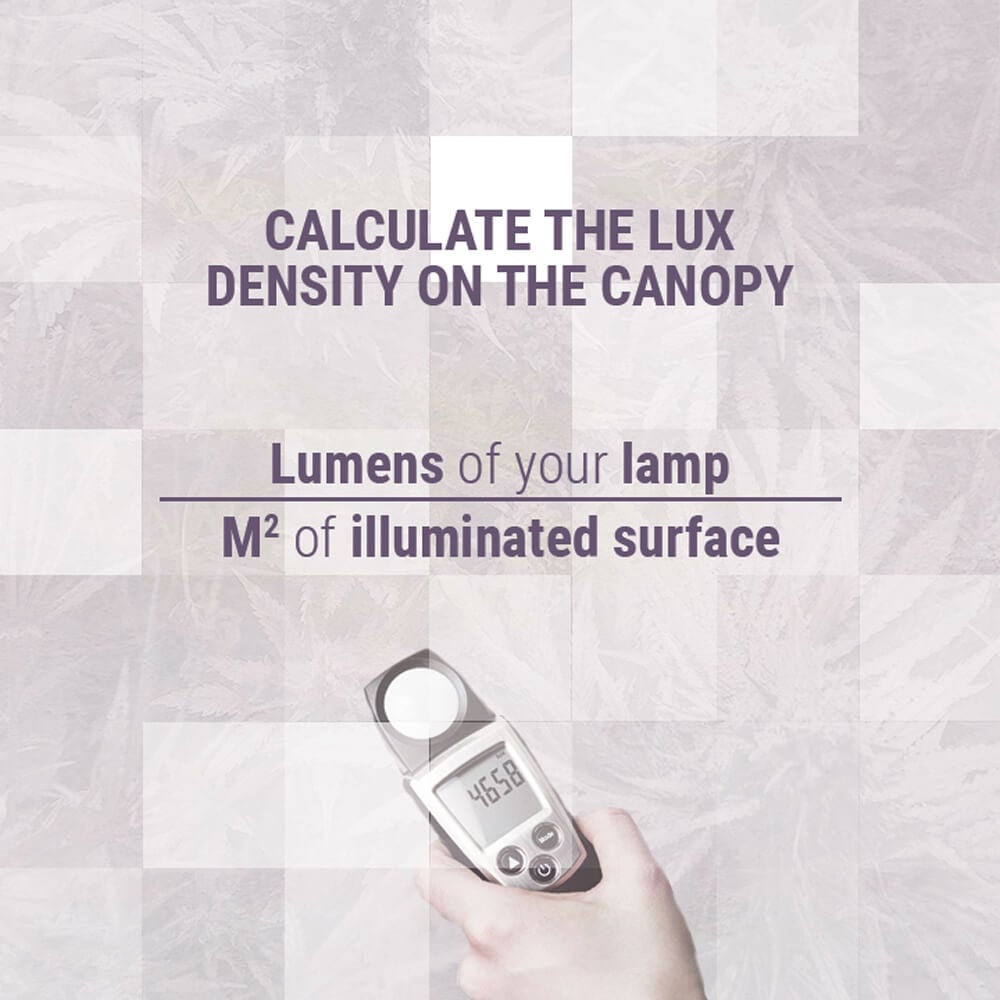
SUN, BULBS, AND PROPER PHOTONIC PRESSURE
Midsummer midday sun reaches the Earth at latitudes of around 45° with a photosynthetic power of 1,200–2,000 PPFD. Yet, cannabis seedlings, clones, and mother plants are happy with a PPFD of just 200–400μmol/m²/s. Cannabis plants in their vegetative phase will need 400–600μmol/m²/s, and flowering plants normally require 600–1500μmol/m²/s PPFD with atmospheric levels of CO₂. A study found that the most productive PPFD for cannabis is 1500–2000μmol/m²/s at a temperature of 25–30°C with natural CO₂ increased to 750ppm.
Even if cannabis is a demanding plant, irradiation above the limit threshold for each variety, stage of life, or environmental conditions doesn’t necessarily increase yield. Conversely, an excess of photonic pressure can cause damage to leaves and flowers. In other words, flower production increases when the cannabis plant receives 20–30 moles of PAR light per day, then levels out between 30–40 moles, and reduces at over 40 moles.
HOW MUCH LIGHT DOES YOUR GROW ROOM NEED?
To establish the correct amount of light for your crop, you need to multiply your grow room length by its width to obtain the growing surface, then multiply the obtained figure with your desired PPFD level.
If your grow box is 97.5 inches long and 31.2 inches wide, your grow space will be 2.50m × 0.80m = 2m². If you aim for a flowering plant canopy of around 2 square metres and you want to experiment with a PPFD level of 500μmol, you simply need 1,000μmol/m²/s. This result should then be divided by the PPFD per watt of light to ascertain the wattage needed.
THE WATTS PER SQUARE METRE RULE: HOW MANY PLANTS CAN YOU GROW?
LED systems produce higher PAR than MH, HPS, and other kinds of lamps. Despite that, your plants will need about the same amount of watts per square metre to achieve a harvest similar to that of traditional HID bulbs. Also consider that LED light systems are often advertised as being more powerful than their actual electrical power draw, but this doesn’t mean that a 400W LED can cover the same square footage as a 1,000W HPS bulb. Here are some general charts of the power needed to grow vigorous cannabis plants using different lighting systems. During the early vegetative stage, they will need around half the power.
As a reference, HPS lights can approximately cover the following canopy areas:
| 250W ≈ 0.5–1m² ≈ 2 plants |
| 400W ≈ 1–1.5m² ≈ 4 plants |
| 600W ≈ 1.3–2m² ≈ 8 plants |
| 1000W ≈ 1.8–3m² ≈ 10 plants |
LED lights can approximately cover the following canopy areas:
| 120W ≈ 0.5m² ≈ 1 plant |
| 200W ≈ 0.8m² ≈ 2 plants |
| 280W ≈ 1m² ≈ 4 plants |
| 350W ≈ 1.5m² ≈ 6–8 plants |
To get an idea of how much light intensity you are providing to your plants, you can buy a lux meter and measure the light intensity over different points of the canopy. Alternatively, you can do a theoretical calculation that considers the lumens emitted by the lamp in relation to the grow surface. In order to calculate the lux pressure on the canopy, just divide the lumens of your lamp by the square metres of the illuminated surface. If you position a lamp that produces 100,000lm at a distance of 1m from the plant’s top, it will illuminate an area of 1m² with an intensity of 100,000lx (100,000lm ÷ 1m = 100,000lx). If the lamp is only 0.5m away, it will receive 100,000lm ÷ 0.5m = 200,000lx.
Unfortunately, the luminous intensity decreases by a factor equal to the square of the source distance from the illuminated object, therefore your same lamp placed at two metres will increase its beam width, covering 4m², but with only 25,000lx. Consequently, you would need four lamps to reach your hypothetical 100,000lx target on your whole grow area.
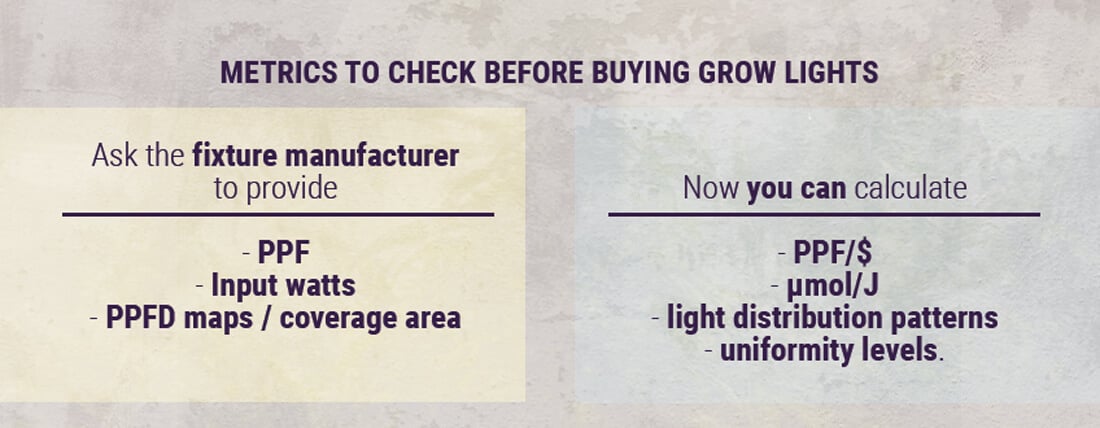
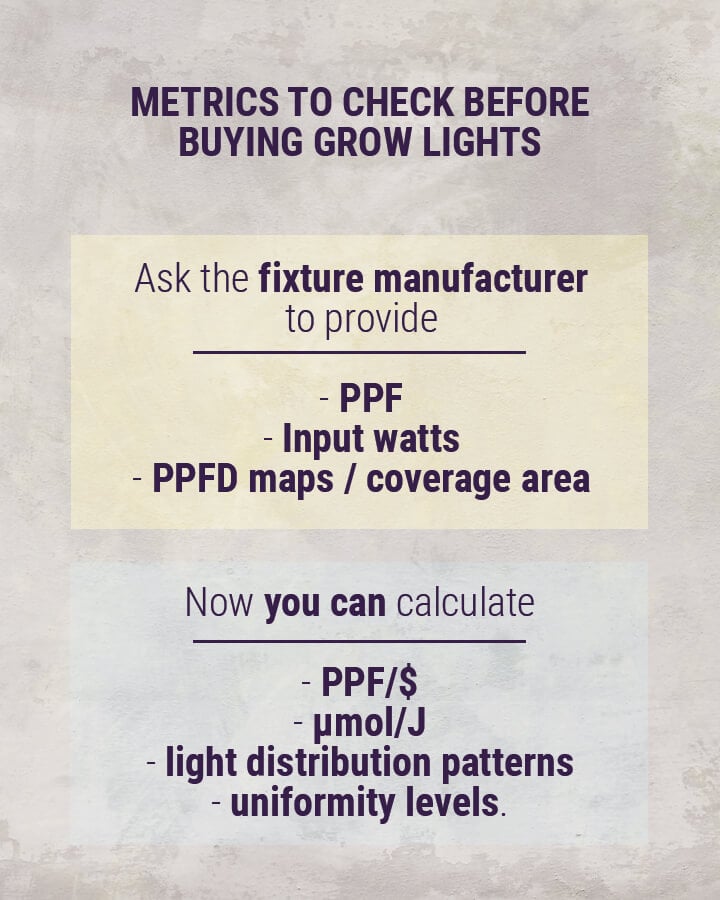
HID (MH, HPS): RULES FOR THE RIGHT DISTANCE
HID bulbs come in a metal halide (MH) version with cold light suitable for the vegetative phase, and a high-pressure sodium (HPS) version with a much wider spectrum for the flowering stage. These lamps run hot and require a proper cooling and exhaust system. They also emit less light over time, thus new bulbs should be kept further away than older bulbs, and after a couple of years, you should consider replacing them.
The proper distance for both MH and HPS bulbs depends mainly on wattage. Always begin with the light at the upper end of the range and gradually lower it. Assuming the ventilation in your grow room is properly set, with a smaller 250W bulb you can start at a distance of 13.7 inches, progressively descending toward the canopy until you reach 9.8 inches from the buds at the end of the flowering stage. With a 600W bulb, you might start at 19.5 inches, descending down to 11.7 inches; if you picked a 1000W lamp, you better allow at least 31.2 inches of distance.
Common practice has you hold the back of your hand facing the light just above the top of your plants; if it feels comfortable, so will your plants. But don’t trust general rules too much. Always check your plants for any signs of overheating or excessive photonic pressure.
How High Should You Hang MH and HPS Grow Lights?
Popular, widely used, and arguably the best for higher yields, many growers are committed to their MH or HPS grow lights.
While MH and HPS are suitable for different stages of the growing cycle, you can generally hang them at a similar distance from your plants. Both lights function best when closer to the crop, but it's good to test them out if it's your first time.
Whether you're a novice grower or are switching things up, we recommend starting at the upper end of the light's range. This way, you can gradually lower it until you're satisfied your plant is getting enough energy. We recommend keeping your light at least 1 – 1.2 feet (12–15") away from the top of the canopy at all times. Remember, looks can be deceiving, and you don't want to heat up the leaves too much.
If you're unsure how much heat the plants are getting, do a quick hand test. Simply place your hand at canopy-height under the light and see how hot it is. If it feels too hot for you, it's also too hot for your plants. Therefore, just move it further away.
One last thing to take into consideration are your bulbs. Not unlike those in your home, a bulb's functionality decreases over time. Since bulbs give off less energy as they age, an older bulb will need to be closer to your plant than a newer one. Similarly, a brand-new one should be kept as far away as possible without sacrificing plant development. Most people replace their MH bulbs at least once a year, whereas HPS users can replace them once every couple.
MH/HPS Grow Light Distance Chart
| STRENGHT | DISTANCE |
|---|---|
| 150W | 20–11.7 inches (8–12") |
| 250W | 25–13.7 inches (10–14") |
| 400W | 1 – 1.6 feet (12–19") |
| 600W | 1.1 – 2.1 feet (14–25") |
| 1000W | 1.3 – 2.6 feet (16–31") |
MH/HPS Grow Light Distance Chart | ||||||
|---|---|---|---|---|---|---|
| STRENGHT | 150W | 240W | 400W | 600W | 1000W | |
| DISTANCE |
0.7 - 1 feet (8–12") |
0.8 – 1.1 feet (10–14") |
1 – 1.6 feet (12–19") |
1.1 – 2.1 feet (14–25") |
1.3 – 2.6 feet (16–31") |
|
LED: RULES FOR THE RIGHT DISTANCE
LED systems run cooler than HID bulbs, but they still need some cooling to prevent accidental burning of your plants. LED lights give off a great amount of light pressure, even at relatively low temperatures. This amount of light itself, not the heat, can cause light burn and leaf bleaching.
Different models of LED grow lights have different optimal distances from plants, and manufacturers usually include recommendations alongside their products. Just start at a medium distance within the recommended range and observe your plants over the coming days. Back the lights off if you notice any leaves turning pale or with burned tips. If your plants are happy, move the LED panel closer, but never to the point where the upper leaves start bleaching, yellowing, or turning brown.
High-wattage LED panels with more than 300W should be kept at least 27.3 inches away from the canopy, then eventually moved closer during the flowering stage. As a general reference, 200–400W LED lights should be positioned 30–27.3 inches away from plants, while 450–600W lights require a distance of 50–31.2 inches. Higher wattage systems must be located even further away. Remember to keep a close watch over your plants whenever you start using a new light.
How High Should You Hang LED Grow Lights?
Go-to grow lights for gardeners, LED lights take a lot of fine-tuning to find an ideal hanging height. However, with so much power, under the right circumstances you can get some amazing yields.
LED lights are tricky. There's so much variety on the market that there's no one-size-fits-all option. As a result, there's no standard distance for them. Basically, whichever unit you choose, manufacturers will provide recommended heights and you'll still wind up fine-tuning.
Another way LED grow lights can trip you up is they don't always look as powerful as they are. Lights appear dim, so it's easy to think they're not emitting enough energy. On the contrary, they're deceptively strong, and you'll need to keep an eye on things. If you don't, your plants could end up bleaching, or you'll end up with an underwhelming crop.
Although every LED grow light is different, as a general rule, hang them further away than you would other lights, and adjust. You can then keep adjusting throughout the plant's grow cycle, moving them closer to the plant as it flowers.
LED Grow Light Distance Chart
Again, all LED grow lights are different, but the following chart should help with some general rules.
| STRENGHT | DISTANCE |
|---|---|
| 240–400W | 1.3 – 2.5 feet (16–30") |
| 450–550W | 1.7 – 2.5 feet (20–30") |
| 600–850W | 2 – 2.2 feet (24–26") |
| 900W+ | 2.2 – 3.5 feet (26–42") |
LED Grow Light Distance Chart | ||||||
|---|---|---|---|---|---|---|
| STRENGHT | 240–400W | 450–550W | 600–850W | 900W+ | ||
| DISTANCE |
1.3 – 2.5 feet (16–30") |
1.7 – 2.5 feet (20–30") |
2 – 2.2 feet (24–26") |
2.2 – 3.5 feet (26–42") |
||
 Grow Guide Topic Finder
Grow Guide Topic Finder
- Growing weed step by step
- Marijuana growing basics
- Choosing your seeds
- How to germinate seeds
- The marijuana vegetative stage
- The marijuana flowering stage
- Harvesting marijuana
- Trimming, drying, and curing
- Choosing pots and soil
-
Growing indoors
- A Complete Overview Of Growing Cannabis Indoors
- Cannabis Cultivation Tips: How To Set Up Indoor Grow Lights
- How Many Cannabis Plants Can You Grow Per Square Metre?
- Indoor Cannabis Growing: Relative Humidity and Temperatures
- Hydroponics Cannabis Growing Guide (with diagrams)
- Cannabis Micro Growing: Growing Great Weed in Tiny Spaces
- Growing outdoors
- How to grow autoflowering marijuana
- Marijuana nutrients and pH
- Marijuana troubleshooting: Nutrients
-
Marijuana troubleshooting: Growing
- Cannabis Seed Germination — Troubleshooting Guide
- How to Deal With Pythium (Root Rot) in Cannabis Plants
- Slow Cannabis Plant Growth And What You Can Do About It
- How to Prevent and Fix Stretching in Cannabis Seedlings
- Watering Your Cannabis: How to Fix Overwatering and Underwatering
- Understanding Male, Female, And Hermaphrodite Cannabis
- Identifying and Treating Common Cannabis Ailments
- How To Revive a Sick Cannabis Plant
- How to Avoid Moldy Marijuana During Drying and Curing
- How to Prevent and Treat Dry and Crispy Cannabis Leaves
- What Cannabis Leaves Can Tell You
- Causes and Solutions for Yellow Cannabis Leaves
-
Marijuana Strains Grow Report
- HulkBerry Automatic Grow Report
- Blue Cheese Auto Grow Report
- Purple Punch Automatic Grow Report
- Triple G Automatic Grow Report
- Do-Si-Dos Automatic Grow Report
- Green Gelato Automatic Grow Report
- Haze Berry Automatic Grow Report
- Purple Queen Automatic Grow Report
- Cookies Gelato Automatic Grow Report
- Sherbet Queen Automatic Grow Report
- Sweet Skunk Automatic Grow Report
- Medusa F1 Grow Report
- Marijuana plant training
-
Marijuana growing tips
- The Cannabis Plant Anatomy
- How to preserve seeds
- How Much Sunlight Do Outdoor Cannabis Plants Need To Grow?
- How to Control and Prevent Stretching in Cannabis Plants
- My Cannabis Plants Are Growing Too Tall: What Should I Do?
- Should You Worry About Purple Or Red Cannabis Stems?
- What To Do When Your Indoor Cannabis Won’t Flower
- How To Protect Your Cannabis Plants From Heat Stress
- How To Tell If Your Female Cannabis Plant Has Been Pollinated
- Growing Medical Marijuana
- Bud Washing: How to Clean Your Weed
- Understanding Cannabis Yield per Plant


























